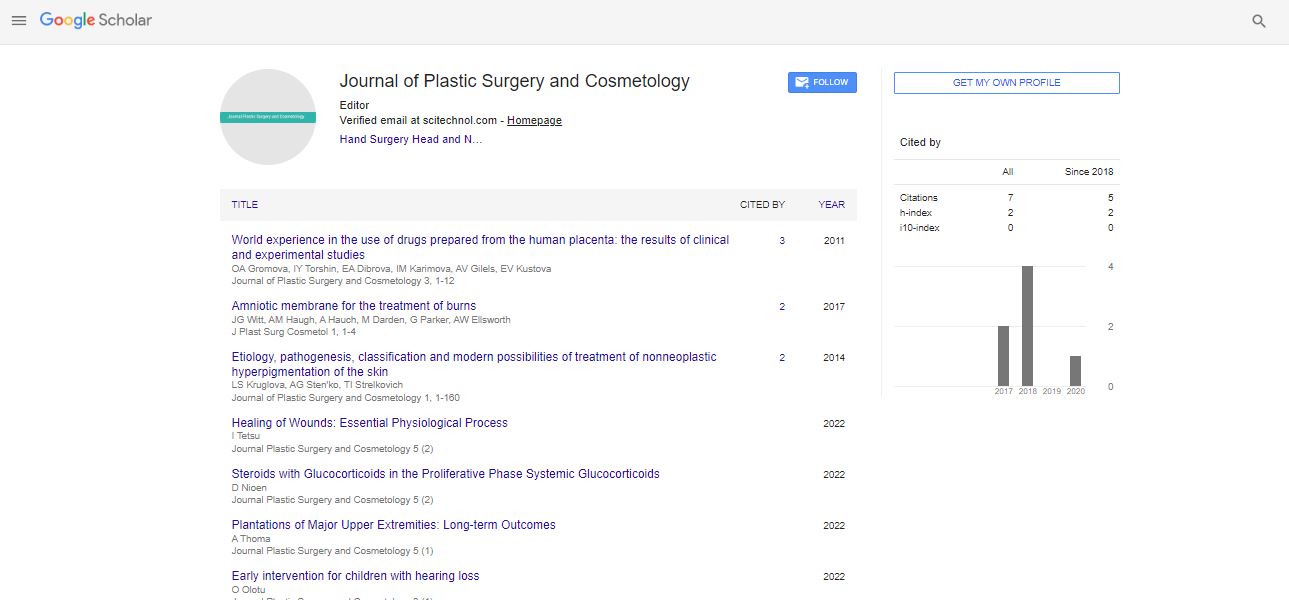A method of oncoplastic reduction of the mammary gland without the formation of pedicle of the nipple-areolar complex
Victoria Przhedetskaya
Federal State Bugetary Institution “National Medical Research Centre of Oncology” of Ministry of health of the
Russian Federation, Russia
: J Plast Surg Cosmetol
Abstract
Purpose of the study: Development of a method for oncoplastic reduction mammoplasty without the formation of a pedicle of the nipple-areolar complex. Materials and methods: A comparative analysis of surgical treatment of breast cancer in 37 patients was carried out. All patients were divided into 2 groups: 22 women in the main group, 15 women in the control group. All patients underwent bilateral reduction of the mammary glands, and on the affected side, the operation was oncoplastic, with regional lymph node dissection or with an urgent morphological study of the sentinel lymph node, and on the healthy side, it was symmetrizing (without lymph node dissection). The reduction mammoplasty technique was identical on both sides. The patients of the main group underwent oncoplastic reduction of the mammary glands without the formation of pedicle of the nipple-areolar complex, with the formation of the nipple from the skin of the mammary gland using one of the three proposed methods. The women of the control group underwent oncoplastic reduction of the mammary glands with the formation of various variants of pedicles of the nipple-areolar complex. Results: Analysis of the data showed the advantage of the proposed method of oncoplastic reduction of the mammary glands without the formation of pedicle of the nipple-areolar complex and the formation of the nipple from the skin of the mammary gland. This method is easier to perform, allows you to significantly reduce the time and increase the oncological radicality of the operation by removing the nipple-areolar complex and most of the ductal system of the gland, as well as avoiding the complications associated with the pedicle of the nipple-areolar complex and achieving good aesthetic results. Conclusion: The proposed method has a list of advantages over the traditional methods of reduction mammoplasty and can be used not only in oncology, but also in aesthetic surgery Literature. Recent Publications: 1. Talghini S. Is macromastia a risk factor for breast cancer? A study on 198 patients //Pak J Biol Sci. 2013 Nov 1;16(21):1348-52. https://doi:10.3923/pjbs.2013.1348.1352. 2. Goldsmith C., Haviland J., Tsang Y., Sydenham M., Yarnold J. Large breast size as a risk factor for late adverse effects of breast radiotherapy: is residual dose inhomogeneity, despite 3D treatment planning and delivery, the main explanation?// Radiother Oncol, 2011. Aug;100(2):236-40. https://doi:10.1016/j. 3. Brown R.H., Izaddoost S., Bullocks J.M. Preventing the "Bottoming Out" and "Star-gazing" Phenomena in Inferior Pedicle Breast Reduction with an Acellular Dermal Matrix Internal Brassiere //Aesthetic Plastic Surgery, 2010 34(6):760- 7. https://doi:10.1007/s00266-010-9538-2. 4. Kankaya Y., Oruç M., Sungur N., et al. Four flap suspension technique for prevention of bottoming out after breast reduction //Ann Surg Treat Res. Jan 2016; 90(1): 10–15. https://doi:10.4174/astr.2016.90.1.10 5. Chang M.M., Huston T, Ascherman J., Rohde C. Oncoplastic Breast Reduction: Maximizing Aesthetics and Surgical Margins // Int J Surg Oncol. 2012; 907576. https://doi:10.1155/2012/907576 6. Piper M., Peled A.W., Sbitany H. Oncoplastic breast surgery: current strategies // Gland Surg. 2015 Apr; 4(2): 154–163. doi: 10.3978/j.issn.2227-684X.2015.03.
Biography
Victoria Przhedetskaya has experience in performing oncoplastic surgeries on the mammary gland. During analyses of her own results, she noted the increased complexity and time costs of performing traditional reduction mammoplasty in cancer patients. A number of ischemic and necrotic complications from the nipple-areolar complex forced the researcher to look for new ways to overcome these problems. This method of operating this category of patients proposed by the author opens up new favorable prospects for surgical treatment of breast cancer in combination with macromastia.
 Spanish
Spanish  Chinese
Chinese  Russian
Russian  German
German  French
French  Japanese
Japanese  Portuguese
Portuguese  Hindi
Hindi 